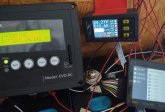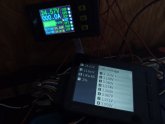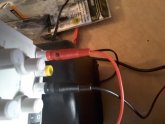Update! Relay attempt and another capacity test.
Relay
I made an attempt to use an Opto 22 Sold State Relay (SSR) with a cheap 15A BMS (8s 24V). Apparently, I didn't hook it up right. I was trying to figure out how to get it to shut off my new Samlex 4000W low-frequency inverter. The Opto 22 started smoking bad, then a loud pop with a piece of plastic flying off of it. There's a $22 lesson learned, ha ha.
As an alternative, I have a 40A 24V electro-magnetic automotive relay. But, I still had trouble trying to connect it to the inverter. The inverter has so many features and configurations, it's not clear how to set it up.
Later, I was reading the inverter manual and discovered the inverter has it's own low-voltage alarm & shutdown (cut off) feature. So, I don't need a relay. RTFM, ha ha.
Capacity Test
I ran another capacity test (2nd test with 1st half of cells (8 of 16 cells - two 24V packs)). I kept the small 15A BMS connected to the battery, but did not have the inverter connected to it (Inverter connected directly to battery). I ended up disconnecting the automotive relay as it was just getting hot and seemingly wasting power. I didn't have the relay switch wires go to anything. It looks like the BMS does not balance when nothing is connected to the P- wire.
Anyway, after getting past the relay issue, my next goal was to figure out how to use the middle 80% capacity of the battery. For this test, I charged the battery to 28V absorb charge, set the low-voltage alarm to 25V, and low-voltage cut-off (shutdown) to 24V.
8 cells @ 280Ah x 25.6V = 7,168Wh (24V nominal)
My thinking was to see about getting 80% of 7,168Wh = 5,734Wh
or
80% of 280Ah = 224Ah
Wanted to get a better feel for ideal upper & lower voltage settings.
1st Pic - The voltage started quickly dropping once I turned the inverter on
2nd Pic - Met the 80% Wh (5,758Wh @ 221Ah @ 25.51V), cells staying somewhat balanced
3rd Pic - 24.2V inverter low-voltage alarm beeps on & off, cells less balanced
4th Pic - Inverter shut itself off at 24V, continuous beep for 30 seconds (I set it to 30 sec) then it shut off, a quick drop from 24.2V in 4 minutes
5th Pic - I let the battery set a couple hours, shows cell recover voltage, still a little out of balance
What's interesting is the 3 meters all show slightly different voltages amongst each other.
Final Result
Beginning to end capacity usage: 28V (3.5V cell) to 24V (3V cell)
272Ah = 97% of 280Ah
7,041Wh = 98% of 7,168Wh
I ended up changing the low-voltage alarm from 25V to 24.2V as it kept beeping as it teetered between 24.9V to 25.1V since I wasn't discharging much, less than 700W at any given time (Refrigerator and home office stuff). It took like another hour or so to get to the 24.2V warning.
I'll do a similar test with my 2nd half of 8 cells. Probably go with 27V to 25V just to see how it compares.
I'm also curious to do a test to see where the quick voltage drop-offs are and set the upper & lower voltage limits to the edges of these drop-offs to see how it compares.















